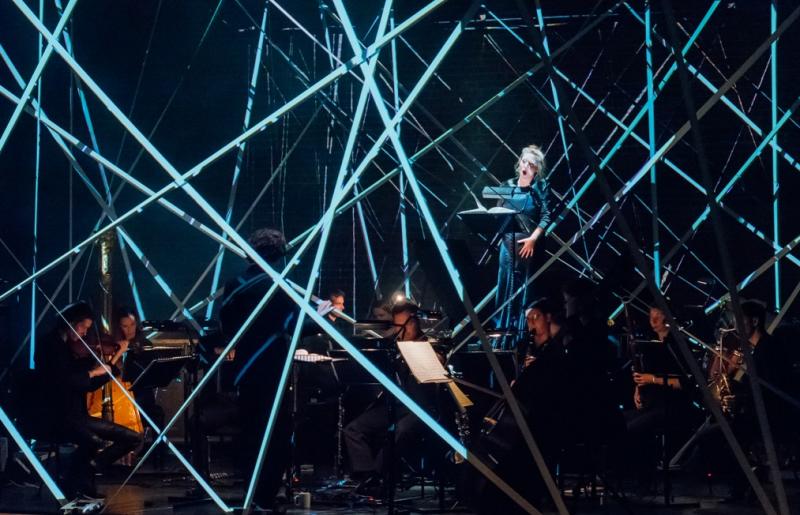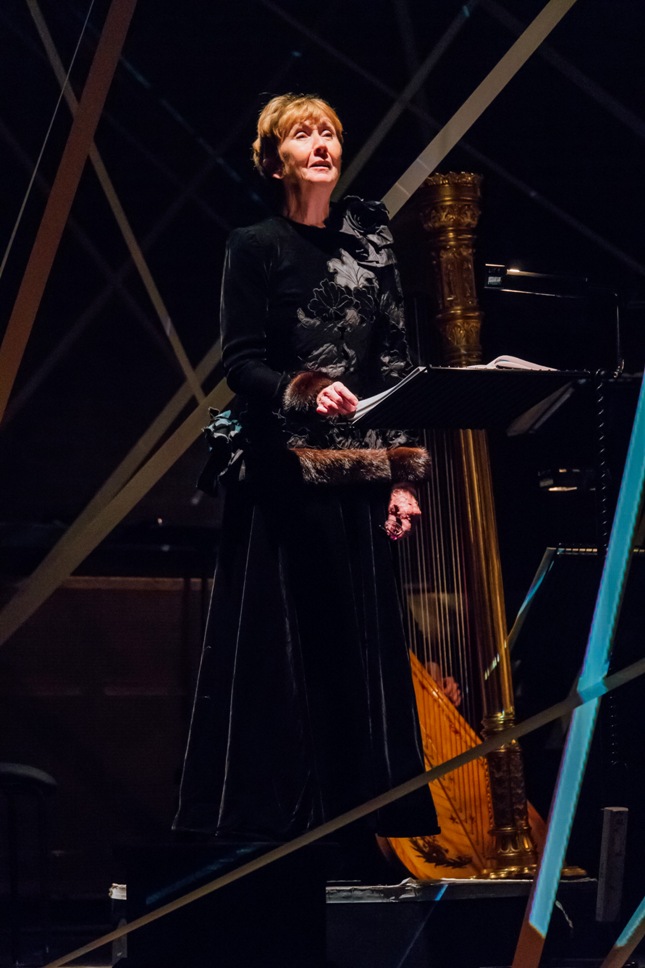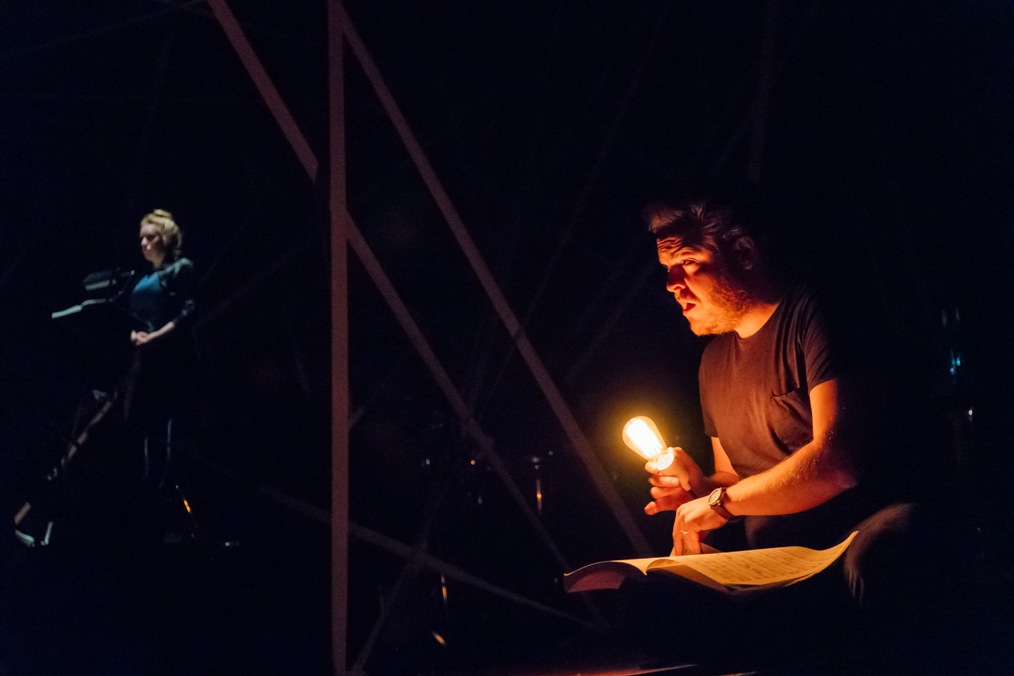The Turn of the Screw, Aurora Orchestra, LSO St Luke's | reviews, news & interviews
The Turn of the Screw, Aurora Orchestra, LSO St Luke's
The Turn of the Screw, Aurora Orchestra, LSO St Luke's
Sophie Bevan is perfect as Britten’s Governess, but lost in a labyrinth

A Hawksmoor church ought to be the right setting for the psychological terror of Britten’s great chamber opera, a slanted but still chilling adaptation of Henry James's novella. True, the once-deroofed interior has been coolly revamped as a rehearsal and performance venue, but imaginative lighting and a clear acting space, with room for a 13-piece ensemble to the side, ought to do the trick.
Unfortunately this setting, straight from Aldeburgh, isn’t exactly that for what its "conceivers" describe as “not a conventionally staged production… not ‘semi-staged’, nor… a concert performance”. It’s static and hems in the imagination rather than letting it flow as power play between the characters shifts, or ought to.
The latticed cube within which most of the performers exist refers both to the child Flora’s cat’s cradle and to the labyrinth in which the protagonist finds herself lost at the beginning of the second act. It's the work of those “conceivers”, Sophie Hunter, Andrew Staples – the most imaginative of tenors, too, singing ghost Quint and the Prologue here – and William Reynolds. The concept has been executed, and brilliantly, by La Fura dels Baus’s Valentina Carrasco in Lyon. But that was dynamic, catching up objects as well as people as the screw turned. Here, while the ghosts first appear, and the children go through rituals, outside the cube, four of the perfomers are stuck rigidly, for most of what they sing, in fixed places behind music stands. The beyond doesn't make for effective glimpses of "the others" before they sing - a glaring light obscured the figures, and since St Luke's makeover has spiral staircases, why not have Quint in a tower as specified rather than on the ground?
 Using scores was the biggest mistake. Sophie Bevan, convincing in every word and every colour as the mind-besieged Governess, certainly didn’t need one; Ann Murray (pictured right), still inflecting with an intelligence and subtlety that suggests housekeeper Mrs Grose understands more than she says, knows her role well. Both ghosts, Staples and Jane Irwin as the former governess complicit in his nameless malignity, projected some wonderful sounds but weren’t note or rhythm perfect last night. Perhaps there hadn't been enough rehearsal time to embed Britten’s superb speech melodies sufficiently deep in their consciousness. And if I say I could sing you the Prologue note for note, that’s not to boast but to point out that like Cole Porter, Janáček or Sullivan setting Gilbert, Britten sets the words so memorably that they embed themselves in the psyche very quickly.
Using scores was the biggest mistake. Sophie Bevan, convincing in every word and every colour as the mind-besieged Governess, certainly didn’t need one; Ann Murray (pictured right), still inflecting with an intelligence and subtlety that suggests housekeeper Mrs Grose understands more than she says, knows her role well. Both ghosts, Staples and Jane Irwin as the former governess complicit in his nameless malignity, projected some wonderful sounds but weren’t note or rhythm perfect last night. Perhaps there hadn't been enough rehearsal time to embed Britten’s superb speech melodies sufficiently deep in their consciousness. And if I say I could sing you the Prologue note for note, that’s not to boast but to point out that like Cole Porter, Janáček or Sullivan setting Gilbert, Britten sets the words so memorably that they embed themselves in the psyche very quickly.
Bevan convinced us of that, capable of soft and melting tones as well as pure white notes but opening up to scary forcefulness from the point at which the Governess jumps to conclusions about what has been happening to the orphan children at Bly and makes her fatal resolve to protect them at any cost. Every phrase has meaning, every top note rings out with that bloom which saw her Sophie stealing the show in Der Rosenkavalier both at ENO and in Birmingham.
Unfortunately Bevan's positioning, the furthest back behind the orchestra, excluded both any ambiguity about whether her imagination is running havoc and the ghosts do exist, and any sense of her coming unwholesomely closer and closer, like Quint, to her charge Miles. Something’s wrong when in the bedroom scene Staples’ seducer hovers above the boy while the Governess is stuck at her post way behind (pictured below, Staples and a distant Bevan).
 The children, Joshua Kenney and a girl rather than a developed soprano, Louise Moseley, as Flora, were scoreless – young Joshua could have done with the prompt in the crucial final scene last night – but musically spot-on, even if this Miles is the kind of cipher on which you project your own imagination. Their rituals are sometimes perceptive, as in the initial reversal of the sexes in their bowing and curtseying, but more often constricting; this concept, like the ghosts and the Governess, never lets them just be normal children.
The children, Joshua Kenney and a girl rather than a developed soprano, Louise Moseley, as Flora, were scoreless – young Joshua could have done with the prompt in the crucial final scene last night – but musically spot-on, even if this Miles is the kind of cipher on which you project your own imagination. Their rituals are sometimes perceptive, as in the initial reversal of the sexes in their bowing and curtseying, but more often constricting; this concept, like the ghosts and the Governess, never lets them just be normal children.
Having the players at the front of the cube allows countless miracles of orchestration to make an even greater mark than usual – the sombre string clashes and high-cello weirdness, the unusual threatening quality of the celesta played by John Reid, whose pianism is astoundingly vivid, the amazing harp writing exquisitely taken by Sally Pryce. But total clarity also means a lack of mystery, and though Nicholas Collon, after a disappointing Glyndebourne-on-Tour Rape of Lucretia, is pitch- and pace-perfect, my flesh crept only when all the voices combined in a sensuous orgy at the end of Act One and at Bevan’s desperation. With her sister Mary hopefully recovering her voice over at the Sam Wanamaker Playhouse, and Louise Alder in that same Orpheus clearly the next in lyric line, we're so lucky with our home-grown sopranos at the moment.
Add comment
The future of Arts Journalism
You can stop theartsdesk.com closing!
We urgently need financing to survive. Our fundraising drive has thus far raised £49,000 but we need to reach £100,000 or we will be forced to close. Please contribute here: https://gofund.me/c3f6033d
And if you can forward this information to anyone who might assist, we’d be grateful.

Subscribe to theartsdesk.com
Thank you for continuing to read our work on theartsdesk.com. For unlimited access to every article in its entirety, including our archive of more than 15,000 pieces, we're asking for £5 per month or £40 per year. We feel it's a very good deal, and hope you do too.
To take a subscription now simply click here.
And if you're looking for that extra gift for a friend or family member, why not treat them to a theartsdesk.com gift subscription?
more Opera
 Cinderella/La Cenerentola, English National Opera review - the truth behind the tinsel
Appealing performances cut through hyperactive stagecraft
Cinderella/La Cenerentola, English National Opera review - the truth behind the tinsel
Appealing performances cut through hyperactive stagecraft
 Tosca, Royal Opera review - Ailyn Pérez steps in as the most vivid of divas
Jakub Hrůša’s multicoloured Puccini last night found a soprano to match
Tosca, Royal Opera review - Ailyn Pérez steps in as the most vivid of divas
Jakub Hrůša’s multicoloured Puccini last night found a soprano to match
 Tosca, Welsh National Opera review - a great company reduced to brilliance
The old warhorse made special by the basics
Tosca, Welsh National Opera review - a great company reduced to brilliance
The old warhorse made special by the basics
 BBC Proms: The Marriage of Figaro, Glyndebourne Festival review - merriment and menace
Strong Proms transfer for a robust and affecting show
BBC Proms: The Marriage of Figaro, Glyndebourne Festival review - merriment and menace
Strong Proms transfer for a robust and affecting show
 BBC Proms: Suor Angelica, LSO, Pappano review - earthly passion, heavenly grief
A Sister to remember blesses Puccini's convent tragedy
BBC Proms: Suor Angelica, LSO, Pappano review - earthly passion, heavenly grief
A Sister to remember blesses Puccini's convent tragedy
 Orpheus and Eurydice, Opera Queensland/SCO, Edinburgh International Festival 2025 review - dazzling, but distracting
Eye-popping acrobatics don’t always assist in Gluck’s quest for operatic truth
Orpheus and Eurydice, Opera Queensland/SCO, Edinburgh International Festival 2025 review - dazzling, but distracting
Eye-popping acrobatics don’t always assist in Gluck’s quest for operatic truth
 MARS, Irish National Opera review - silly space oddity with fun stretches
Cast, orchestra and production give Jennifer Walshe’s bold collage their all
MARS, Irish National Opera review - silly space oddity with fun stretches
Cast, orchestra and production give Jennifer Walshe’s bold collage their all
 Káťa Kabanová, Glyndebourne review - emotional concentration in a salle modulable
Janáček superbly done through or in spite of the symbolism
Káťa Kabanová, Glyndebourne review - emotional concentration in a salle modulable
Janáček superbly done through or in spite of the symbolism
 Buxton International Festival 2025 review - a lavish offering of smaller-scale work
Allison Cook stands out in a fascinating integrated double bill of Bernstein and Poulenc
Buxton International Festival 2025 review - a lavish offering of smaller-scale work
Allison Cook stands out in a fascinating integrated double bill of Bernstein and Poulenc
 Tosca, Clonter Opera review - beauty and integrity in miniature
Happy surprises and a convincing interpretation of Puccini for today
Tosca, Clonter Opera review - beauty and integrity in miniature
Happy surprises and a convincing interpretation of Puccini for today
 Hamlet, Buxton International Festival review - how to re-imagine re-imagined Shakespeare
Music comes first in very 19th century, very Romantic, very French operatic creation
Hamlet, Buxton International Festival review - how to re-imagine re-imagined Shakespeare
Music comes first in very 19th century, very Romantic, very French operatic creation
 Falstaff, Glyndebourne review - knockabout and nostalgia in postwar Windsor
A fat knight to remember, and snappy stagecraft, overcome some tedious waits
Falstaff, Glyndebourne review - knockabout and nostalgia in postwar Windsor
A fat knight to remember, and snappy stagecraft, overcome some tedious waits

Comments
I thought it was amazing -